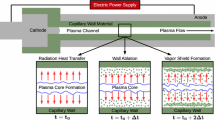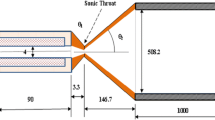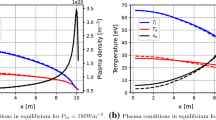Abstract
Electrothermal (ET) plasma discharges are capillary discharges that ablate liner materials and form partially ionized plasma. ET plasma discharges are generated by driving current pulses through a capillary source with peak currents on the order of tens of kA and pulse lengths on the order of \(100\,\upmu \hbox {s}\). These plasma discharges can be used to propel pellets into magnetic confinement fusion devices for deep fueling of the fusion reaction, ELM mitigation, and thermal quench of the fusion plasma. ET plasma discharges have been studied using 0D, 1D, and semi-2D fluid models. In this work, a fully 2D model of ET plasma discharges is presented. The newly developed model and code resolve inter-species interaction forces due to elastic collisions. These forces affect the plasma flow field in the source and impede the development of plasma pressure at the exit of the source. In this work, these affects are observed for discharge current pulses peaking at 10 and 20 kA. The sensitivity of the model to the inclusion of charge exchange effects is observed. The inclusion of charge exchange has little effect on the integrated, global results of the simulation. The difference in total ablated mass for the simulations caused by the inclusion of charge exchange reactions is <1 %. Differences in local plasma parameters are observed during discharge initialization, but after initialization, these differences diminish. The physical reasoning for this is discussed and recommendations are made for future modeling efforts.









Similar content being viewed by others
References
N. AlMousa, L. Winfrey, J. Gilligan, M. Bourham, Radiative heat transport through vapor plasma for fusion heat flux studies and electrothermal plasma sources applications. J. Nucl. Energy Sci. Power Gener. Technol. 3(1), 1–7 (2014)
J. Bittencourt, Fundamentals of Plasma Physics, 3rd edn. (Springer, New York, 2010)
M. Bourham, O. Hankins, O. Auciello, J. Stock, B. Wehring, R. Mohanti, J. Gilligan, Vapor shielding and erosion of surfaces exposed to a high heat load in an electrothermal accelerator. IEEE Trans. Plasma Sci. 17(3), 386–391 (1989)
S. Braginskii, in Review of Plasma Physics, vol. 1, ed. by M.A. Leontovitch (Consultants Bureau, New York, 1965), p. 217
J. Eapen, Theoretical and numerical foundations for simulation of ablative plasma flow in electrothermal-chemical mass accelerators. Master’s thesis, North Carolina State University, Raleigh, 1998
J. Echols, Investigation of tungsten surface effects under high heat flux conditions. Master’s thesis, Virginia Tech, Blacksburg, 2014
J. Echols, A. Winfrey, Ablation of fusion materials exposed to high heat flux in an electrothermal plasma discharge as a simulation for hard disruption. J. Fusion Energ. 33, 60–67 (2014)
C. Edwards, M. Bourham, J. Gilligan, Experimental studies of the plasma-propellant interface for electrothermal-chemical launchers. IEEE Trans. Magn. 31(1), 404–409 (1995)
T. Gebhart, R. Holladay, M. Esmond, A. Winfrey, Optimization of fusion pellet launch velocity in an electrothermal mass accelerator. J. Fusion Energ. 33, 32–39 (2014)
J. Gilligan, M. Bourham, The use of an electrothermal plasma gun to simulate the extremely high heat flux conditions of a tokamak disruption. J. Fusion Energ. 12(3), 311–316 (1993)
J. Gilligan, R. Mohanti, Time-dependent numerical simulation of ablation-controlled arcs. IEEE Trans. Plasma Sci. 18(2), 190–197 (1990)
V. Golant, A. Zhilinsky, I. Sakharov, Fundamentals of Plasma Physics (Wiley, New York, 1980)
D. Hahn, J. Gilligan, Radiation transport through a plasma boundary layer between armatures and material surfaces. IEEE Trans. Magn. 27(1), 251–256 (1991)
N. Hahn, Energy transport through the plasma boundary layer. Ph.D. thesis, North Carolina State University, Raleigh, 1989
M. Hamer, Design of optical measurements for electrothermal plasma discharges. Master’s thesis, Virginia Tech, Blacksburg, 2014
J. Hurley, M. Bourham, J. Gilligan, Numerical simulation and experiment of plasma flow in the electrothermal launcher sirens. IEEE Trans. Magn. 31(1), 616–621 (1995)
R. Janev, J. Smith, Cross sections for collision processes of hydrogen atoms with electrons, protons and multiply charged ions. At. Plasma-Mater. Interact. Data Fusion 4(1), 78–79 (1993)
R. Kincaid, M. Bourham, Electrothermal plasma gun as a pellet injector. J. Fusion Technol. 26(3), 637–641 (1994)
R. Majumdar, J. Gilligan, A. Winfrey, M. Bourham, Supersonic flow patterns from electrothermal plasma source for simulated ablation and aerosol expansion following a fusion disruption. J. Fusion Energ. 33, 25–31 (2014)
R. Majumdar, J. Gilligan, A. Winfrey, M. Bourham, Scaling laws of bulk plasma parameters for a 1-d flow through a capillary with extended convergingdiverging nozzle for simulated expansion into fusion reactor chamber. J. Fusion Energ. 34, 905–910 (2015)
E. Meier, U. Shumlak, A general nonlinear fluid model for reacting plasma-neutral mixtures. Phys. Plasmas 19, 072508 (2012)
N. Orton, Boundary layer energy transport in plasma devices. Ph.D. thesis, North Carolina State University, Raleigh (2000)
A. Porwitzky, An end-to-end model of an electrothermal chemical gun. Ph.D. thesis, The University of Michigan, Ann Arbor, 2008
J. Powell, A. Zielinski, Capillary discharge in the electrothermal gun. IEEE Trans. Plasma Sci. 29(1), 591–596 (1993)
C. Ruchti, L. Niemeyer, Ablation controlled arcs. IEEE Trans. Plasma Sci. 14(4), 423–434 (1986)
A. Winfrey, A numerical study of the non-ideal behavior, parameters, and novel applications of an electrothermal plasma source. Ph.D. thesis, North Carolina State University, Raleigh, 2010
A. Winfrey, M. Al-Halim, A. Saveliev, J. Gilligan, M. Bourham, Enhanced performance of electrothermal plasma sources as fusion pellet injection drivers and space based mini-thrusters via extension of a flattop discharge current. J. Fusion Energ. 32, 371–377 (2013)
A. Winfrey, M.A. Al-Halim, J. Gilligan, A. Saveliev, M. Bourham, A study of plasma parameters in a capillary discharge with calculations using ideal and nonideal plasma models for comparison with experiment. IEEE Trans. Plasma Sci. 40(3), 843–852 (2012)
A. Winfrey, J. Gilligan, M. Bourham, A computational study of a capillary discharge pellet accelerator concept for magnetic fusion fueling. J. Fusion Energ. 32, 227–234 (2013)
F. Witherspoon, R. Burton, S. Goldstein, A second generation emet railgun for secondary arc studies. IEEE Trans. Magn. 27(1), 91–96 (1991)
L. Woods, An Introduction to the Kinetic Theory of Gases and Magnetoplasmas (Oxford University Press, New York, 1993)
M. Zaghloul, Improved modelling of electrothermal plasma source with radiation transport. J. Phys. D Appl. Phys. 41, 225206 (2008)
M. Zaghloul, M. Bourham, J. Doster, Semi-analytical modelling and simulation of the evolution and flow of ohmically-heated non-ideal plasmas in electrothermal guns. J. Phys. D Appl. Phys. 34, 772–786 (2001)
M. Zaghloul, M. Bourham, J. Doster, J. Powell, On the average electron-ion momentum transport cross-section in ideal and non-ideal plasmas. Phys. Lett. A 262(1), 86–89 (1999)
Acknowledgments
This work is made possible by the Virginia Tech Nuclear Engineering Program. The authors acknowledge Advanced Research Computing at Virginia Tech for providing computational resources that have contributed to the results reported within this work.
Author information
Authors and Affiliations
Corresponding author
Rights and permissions
About this article
Cite this article
Esmond, M.J., Winfrey, A.L. Flow Characteristics and Charge Exchange Effects in a Two-Dimensional Model of Electrothermal Plasma Discharges. J Fusion Energ 35, 244–252 (2016). https://doi.org/10.1007/s10894-015-0013-6
Published:
Issue Date:
DOI: https://doi.org/10.1007/s10894-015-0013-6




